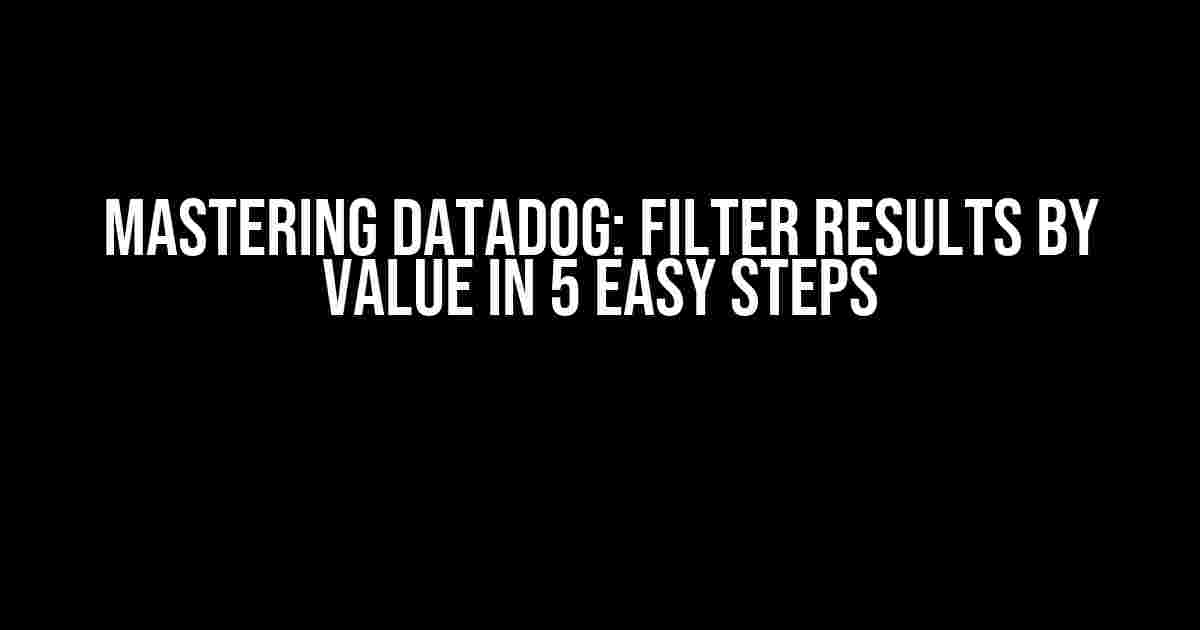Are you tired of sifting through a sea of data in Datadog, searching for that one specific metric or result? Do you wish you could narrow down your search to quickly find what you’re looking for? Well, you’re in luck! In this article, we’ll show you how to filter results by value in Datadog, taking your monitoring and analytics skills to the next level.
Why Filtering by Value Matters
In Datadog, you’re constantly dealing with vast amounts of data. Without proper filtering, it’s easy to get lost in the noise. By filtering results by value, you can:
- Quickly identify trends and anomalies
- Isolate specific issues or performances
- Optimize resource allocation and budgeting
- Enhance overall monitoring and analytics capabilities
Step 1: Access the Query Editor
To filter results by value, you’ll need to access the Query Editor in Datadog. To do this:
- Log in to your Datadog account and navigate to the
MetricsorLogssection - Click on the
New MetricorNew Logbutton - In the query editor, click on the
Filtertab
Step 2: Choose Your Filter Type
In the filter tab, you’ll see a dropdown menu labeled Filter by. Here, you can choose from various filter types, such as:
Value: Filter by a specific value or range of valuesTag: Filter by a specific tag or tag valueMetric: Filter by a specific metric or metric value
For this example, we’ll choose Value as our filter type.
Step 3: Define Your Filter Criteria
Now it’s time to define your filter criteria. In the Value filter type, you can choose to filter by:
Equals: Filter for exact matchesNot Equals: Filter for values that do not matchContains: Filter for values that contain a specific stringDoes Not Contain: Filter for values that do not contain a specific stringGreaterThan: Filter for values greater than a specified valueLessThan: Filter for values less than a specified valueInRange: Filter for values within a specified rangeNotInRange: Filter for values outside a specified range
For example, let’s say we want to filter for all values greater than 50. We would choose the GreaterThan operator and enter 50 as the value.
Filter by: Value Operator: GreaterThan Value: 50
Step 4: Apply Your Filter
Once you’ve defined your filter criteria, click the Apply button to apply the filter to your results.
You’ll notice that your query results have been filtered according to your specified criteria. You can now analyze and explore your filtered data with ease.
Step 5: Refine and Save Your Filter
To refine your filter, you can add additional criteria by clicking the Add filter button. This allows you to combine multiple filters to further narrow down your results.
Once you’re satisfied with your filter, be sure to save it by clicking the Save button. This will save your filter as a reusable query that you can access later.
| Filter Name | Filter Criteria | Operator | Value |
|---|---|---|---|
| My Filter | Value | GreaterThan | 50 |
Tips and Variations
Here are some additional tips and variations to take your filtering skills to the next level:
- Use the
ANDandORoperators to combine multiple filters - Filter by multiple values using the
Inoperator - Use wildcards (
*) to filter for values containing a specific string - Filter by date and time using the
Datefilter type
By mastering the art of filtering by value in Datadog, you’ll be able to uncover insights and trends that were previously hidden. Remember to experiment with different filter types, operators, and criteria to unlock the full potential of your data.
Conclusion
In this article, we’ve shown you how to filter results by value in Datadog using a simple, 5-step process. By following these instructions and exploring the various filter types and operators available, you’ll be able to:
- Streamline your data analysis and monitoring workflows
- Uncover hidden insights and trends
- Optimize resource allocation and budgeting
- Take your Datadog skills to the next level
So what are you waiting for? Start filtering by value in Datadog today and unlock the full potential of your data!
Frequently Asked Questions
Get the answers to your burning questions about filtering results by value in Datadog!
What is the purpose of filtering results by value in Datadog?
Filtering results by value in Datadog allows you to narrow down your search to specific data points that match certain conditions, making it easier to identify trends, patterns, and correlations within your data.
How do I filter results by value in Datadog?
To filter results by value in Datadog, you can use the “Filter” button in the top-right corner of the query results. From there, select the column you want to filter by, choose the operator (e.g. “is”, “is not”, “contains”, etc.), and enter the value you want to filter by.
Can I filter by multiple values in Datadog?
Yes, you can filter by multiple values in Datadog using the “OR” and “AND” operators. This allows you to create more complex filters and narrow down your results to specific combinations of values.
Can I save my filtered results in Datadog?
Yes, you can save your filtered results in Datadog as a new dashboard or as a saved view. This allows you to easily access and share your filtered data with others, and to revisit your analysis at a later time.
Are there any limitations to filtering results by value in Datadog?
While filtering results by value is a powerful feature in Datadog, there are some limitations to be aware of, such as the maximum number of filters you can apply and the potential impact on query performance. Be sure to check the Datadog documentation for the most up-to-date information on filtering limitations.
